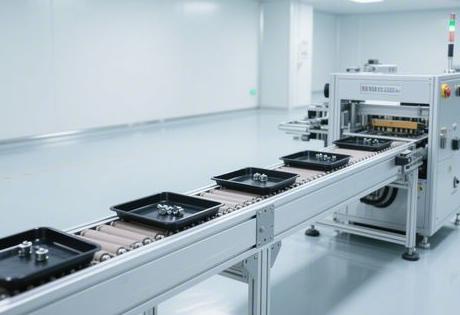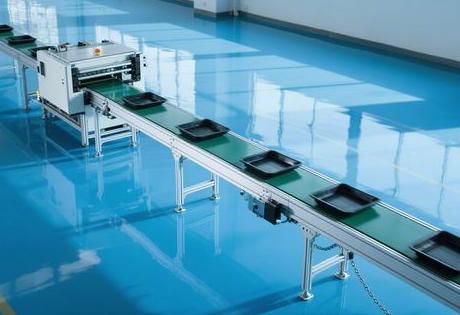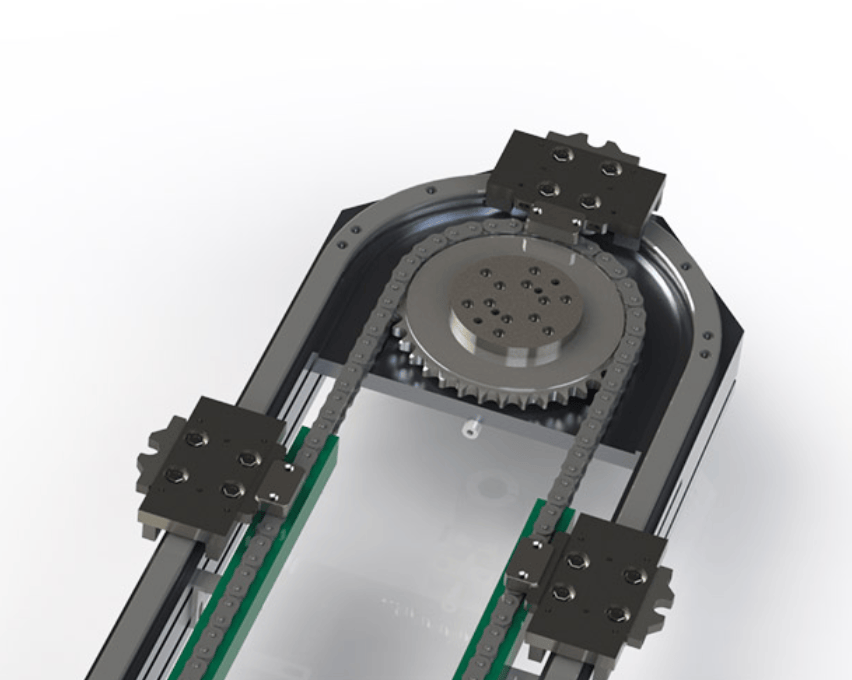In the rapid development of new energy industry, power battery as the core component of electric vehicle and energy storage system, its production efficiency and manufacturing precision directly determines the market competitiveness of the product. The "invisible force" that supports this precision manufacturing process is the battery double-layer speed chain conveyor line - the core equipment that integrates mechanical dynamics and intelligent control technology.

I. Re-conceptualising the double-deck speed chain: more than just a conveyor belt
Traditionally, conveyor lines have been understood simply as "conveyor belts", but the term "conveyor line" has been used for many years.The double-layer speed chain system is a highly synergistic, precision-engineered system.Its core structure is divided into two layers: the upper layer is responsible for the assembly and conveying of battery modules. Its core structure is divided into two layers: the upper layer is responsible for the assembly conveyance of battery modules, while the lower layer realises the automatic return of unloaded work plates. Through the vertical articulation of the transfer machine, the system forms a closed-loop cycle, and the space utilisation rate is increased by more than 50%.
Compared to single-deck conveyor linesThe revolutionary breakthrough of the double-layer structure is the decoupling of the production beat and the return efficiency.In lithium battery PACK (battery pack) assembly. In the lithium battery PACK (battery pack) assembly, when the battery cell finished welding, testing and enter the cooling section, the lower layer can synchronously recover the previous batch of the work plate, to achieve "zero gap" production line connection. This design makes the daily output of modules of a head battery enterprise jump from 8,000 groups to 12,000 groups.
Second, how the speed chain drives the battery intellectual upgrade
The special characteristics of battery production present a triple challenge for conveyor systems.High precision positioning (±0.05mm), anti-static control, heavy duty stability. The solution of the Peppy Chain is subtle:
- Differential Efficiency Mechanism: Speed superposition is achieved by the diameter difference between the roller (diameter D) and the roller (diameter d). When the chain runs at low speed v₀, the actual speed of the workpiece reaches v₀×(1+D/d), which meets the demand of high-speed conveying while maintaining the chain life. Taking 3 times speed chain (D=2d) as an example, the chain speed only needs 2m/min to achieve the conveying speed of 6m/min for the workpiece.
- Dynamic stop-start control: At key stations such as liquid injection and chemical formation, pneumatic stopper with photoelectric sensor achieves millimetre-level positioning. When the work plate stops, the chain underneath continues to run, avoiding shock and vibration through friction slippage, and guaranteeing the precision of electrolyte injection.
- Material Innovation BreakthroughFor the explosion-proof requirements of lithium battery workshop, carbon fibre reinforced nylon rollers are combined with stainless steel chain plates, which not only meets the demand of 2000kg heavy loads (such as energy storage battery modules), but also conductive coating to export static electricity charge.
III. Key technology games in design and manufacturing
While working on a battery plant conveyor line upgrade project, I became acutely aware of three often overlooked design conflicts:
- Trade-off between growth rate ratio and loadThe pursuit of 3 times the speed needs to increase the diameter of the roller, but limited by the 50.8mm pitch (industry standard chain pitch), too large roller will weaken the lateral stability. In the end, 2.5 times the speed + wider aluminium profile guideway solution was adopted to increase the load capacity by 30% while maintaining the line speed of 15m/min.
- The Paradox of Flexibility and RigidityTo adapt to the production of multi-model batteries, the tooling plate needs to be modularly assembled (e.g. switching between 21700 cylindrical batteries and blade batteries). However, frequent disassembly and assembly will easily lead to wear and tear of the positioning pins. The innovative introduction of magnetic locking + RFID identification system not only ensures the rigidity of the connection, but also automatically identifies the type of the workpiece.
- Pain Points in Intelligent O&MTraditional tensioning devices require manual inspection, while the battery workshop environment restricts personnel access. Now through the integration of strain sensors and IoT module, real-time monitoring of chain tension fluctuations, when the deviation>15% automatically trigger the tensioning motor, failure downtime reduced by 70%.
IV. Beyond the electronics industry: unique adaptations for battery scenarios
Despite its origins in electronic assembly lines, the multiplier chain has shown itself to be irreplaceable in the battery sector:
- Thermal Management SynergyIn the module cooling section, the work plate is embedded with cooling pipelines, which are automatically connected with the quick-change fittings of the line body to achieve the synchronisation of conveying and liquid cooling.
- Safe and explosion-proof designBrushless DC motors + pneumatic seals eliminate the risk of electrical sparks and comply with ATEX Zone 2 standards.
- Cleanliness Guarantee: Aluminium profile rail with integrated negative pressure dust extraction port, real-time collection of metal debris (e.g. laser welding residue), maintaining class 10,000 cleanliness.
Measured data from an energy storage battery project shows that compared to a conventional drum line, theMultiplier chain system enables single GWh production line
- Reduction in staffing by 40% (elimination of manual transfers)
- Site Compression 35% (double-deck construction)
- Product scratch rate reduced to less than 0.02% (no pallet friction)
V. Future Evolution: Three Major Trends in Deep Integration with Intelligent Manufacturing
Based on field observations of several battery factories, I believe that the multiplier chain system is undergoing an essential change:
- Digital Twin Drive: Reduced the start-up time of a new line at an enterprise from 45 days to 18 days by previewing mechanical interference problems through virtual commissioning.
- Energy self-consistency model: Integration of supercapacitors in the tooling board, using block braking energy recovery, reducing system energy consumption by 22%
- The Modular RevolutionIntroduced "Lego-style" standard sections (2m each) to support rapid on-site reconfiguration of production lines, reducing changeover time from 72 hours to 8 hours.
These innovations are blurring the boundaries between mechanical conveying and intelligent control, allowing the speed chain system to evolve into the "arterial neural network" of the battery's smart factory.
Ask Yourself: Explaining the Core Questions
Q1: Why does battery production favour double-layer over single-layer doubler chains?

The double-layer structure realises the closed-loop cycle of "produce from the top and return to the bottom", solves the problem of empty boards returning to the single-layer line and occupying the production space, and is especially suitable for the scenario that the weight ratio of the workpiece boards to the products such as the battery module is large (usually 1:3).
Q2: How to deal with chain wear under 2000kg heavy load?
The dual design of steel roller + reinforced sleeve, together with self-lubricating bushing, the life span is still up to 50,000 hours under 3 times speed operation. At the same time, the tensioning system adopts hydraulic buffer to avoid the impact of heavy load start and stop fracture.
Q3: What indicators determine the accuracy of battery conveyor line?
There are three key indexes: positioning repeatability (±0.05mm), speed volatility (<2%), and workpiece plate translation offset (<0.1°). The servo motor is closed-loop controlled by a laser range finder, and a wedge-shaped guideway is used to suppress side-swing.
Q4: Where is the direction of future breakthrough?
正在探索磁悬浮Double Chain Technology,取消物理接触传动,实现零摩擦、免润滑运行,特别适合对金属粉尘零容忍的固态电池车间。














